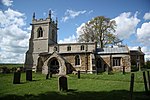St Michael and All Angels Church, Edmondthorpe
13th-century church buildings in England14th-century church buildings in England15th-century church buildings in EnglandBorough of MeltonChurch of England church buildings in Leicestershire ... and 3 more
Churches preserved by the Churches Conservation TrustEnglish Gothic architecture in LeicestershireGrade I listed churches in Leicestershire

St Michael and All Angels Church is a redundant Anglican church in the village of Edmondthorpe, Leicestershire, England. It is recorded in the National Heritage List for England as a designated Grade I listed building, and is under the care of the Churches Conservation Trust.
Excerpt from the Wikipedia article St Michael and All Angels Church, Edmondthorpe (License: CC BY-SA 3.0, Authors, Images).St Michael and All Angels Church, Edmondthorpe
Edmondthorpe Drift, Melton Wymondham
Geographical coordinates (GPS) Address Nearby Places Show on map
Geographical coordinates (GPS)
| Latitude | Longitude |
|---|---|
| N 52.7488 ° | E -0.7302 ° |
Address
Edmondthorpe Drift
LE14 2JU Melton, Wymondham
England, United Kingdom
Open on Google Maps










